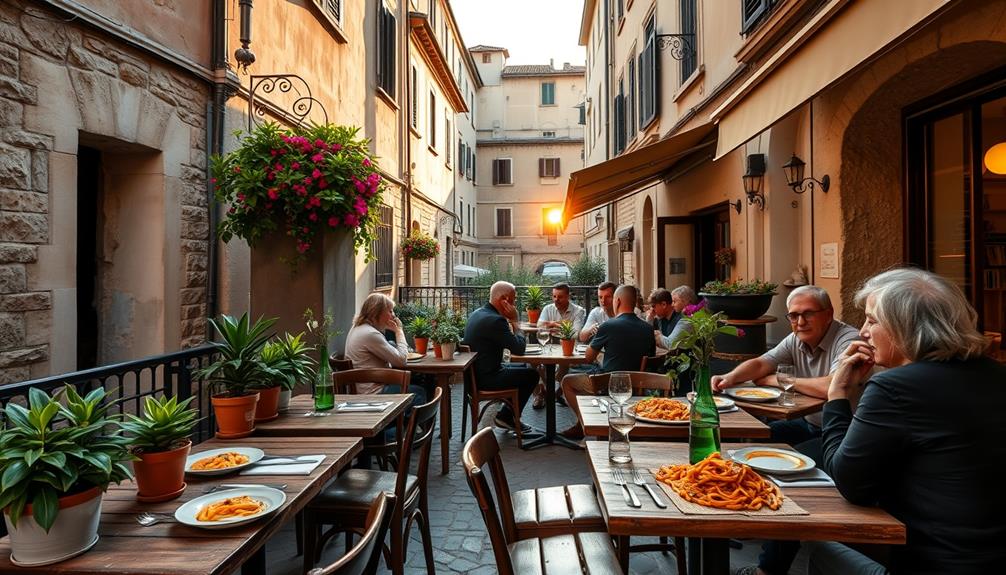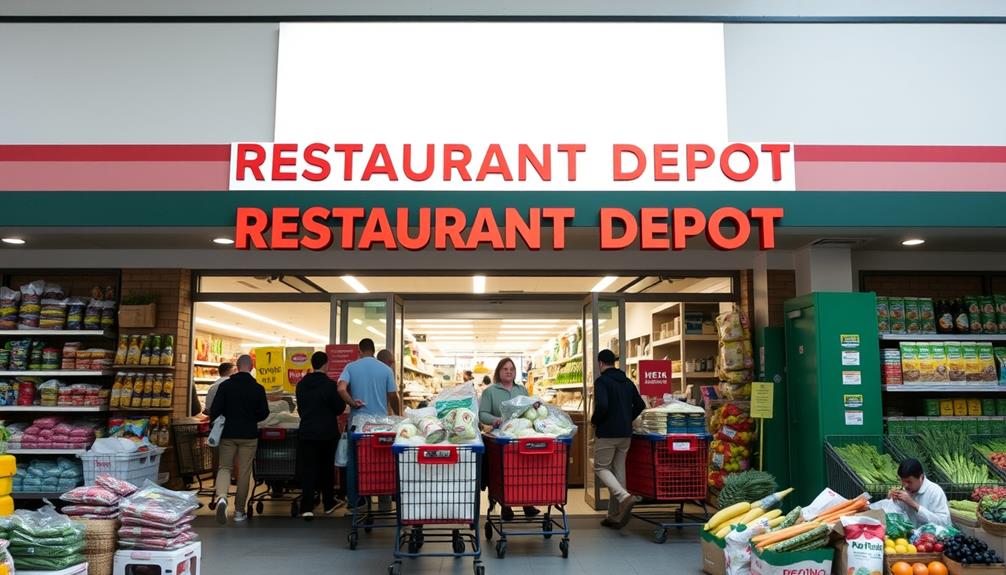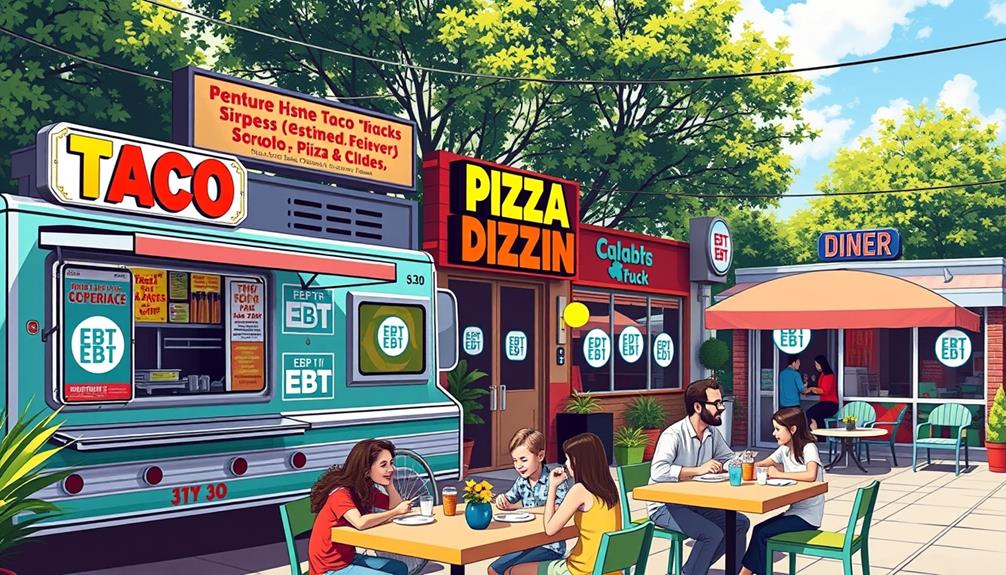A hibachi restaurant is a unique dining experience where you enjoy delicious grilled dishes prepared right in front of you by skilled chefs. These chefs combine culinary expertise with entertainment, performing tricks while cooking, like tossing shrimp or igniting flames. You'll find a communal table that seats about 15 diners, encouraging interaction and camaraderie among guests. The menu often includes mouthwatering options like hibachi chicken, steak, and fresh vegetables, all cooked at high temperatures to preserve flavors. It's more than just a meal; it's an unforgettable event with a lively atmosphere. There's much more to discover about this entertaining dining style! Many hibachi restaurants also offer a variety of sushi and sashimi options, providing a well-rounded dining experience for seafood enthusiasts. Additionally, dining at hibachi allows guests to witness the artistry of food preparation up close, creating a heightened sense of appreciation for the culinary craft. From the sizzling sound of the grill to the vibrant colors of the fresh ingredients, dining at hibachi is a feast for the senses.
Key Takeaways
- Hibachi restaurants provide a unique dining experience that combines meal preparation with entertainment, fostering a communal atmosphere among diners.
- Chefs perform entertaining cooking shows, engaging audiences with tricks and humor while preparing meals on a hibachi grill.
- The menu typically features grilled meats, seafood, and vegetables, often served with fried rice, noodles, or salads, alongside Japanese appetizers.
- The dining atmosphere is lively, with sizzling grills and cheerful chef-diner interactions, creating memorable experiences for guests.
- Hibachi originated from the Heian period in Japan and has evolved from a heating device to a popular cooking method in restaurants today.
Overview of Hibachi Restaurants
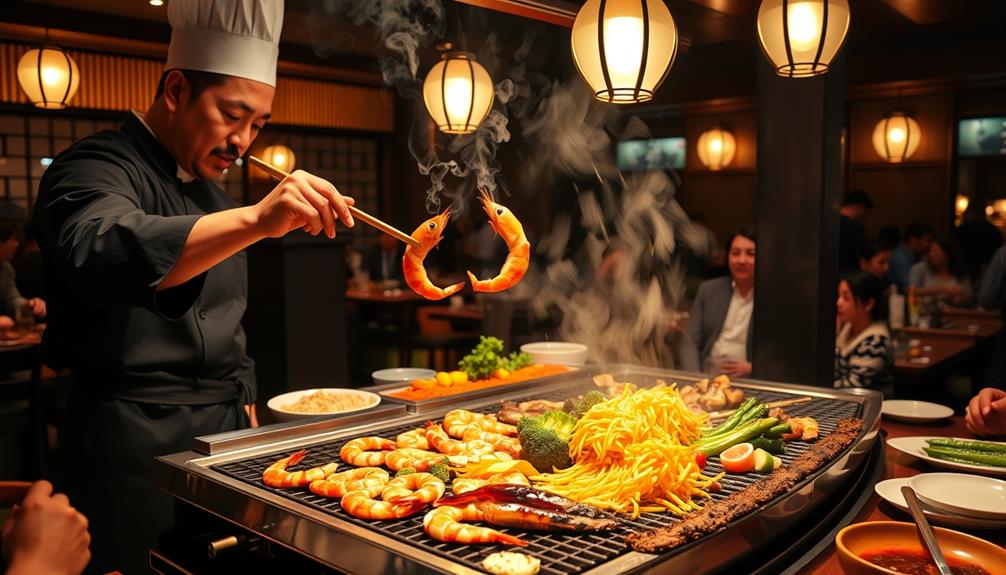
Hibachi restaurants typically offer a unique dining experience that blends entertainment with a delicious meal. When you step into one of these venues, you'll find a hibachi grill integrated into a seating area designed for about 15 diners. This setup allows you to enjoy your meal while watching as skilled chefs use their culinary prowess right before your eyes.
The interactive cooking experience enhances the excitement as orders are taken collectively, and food is served continuously as it's grilled. Additionally, the atmosphere in hibachi restaurants can be likened to the vibrant energy found in coffee culture, where community engagement plays a key role in enhancing the overall experience.
The atmosphere in hibachi restaurants is lively and engaging, often characterized by the camaraderie that forms between diners sharing tables, even with strangers. You'll savor various Japanese food dishes prepared on the grill, from succulent meats to fresh vegetables.
While the decor is minimalistic, featuring natural materials like brown wood and black-and-white marble, it creates a serene backdrop for the vibrant dining experience. Plus, with moderate pricing, hibachi restaurants offer a more affordable option compared to upscale steakhouses or seafood establishments.
The Role of Hibachi Chefs
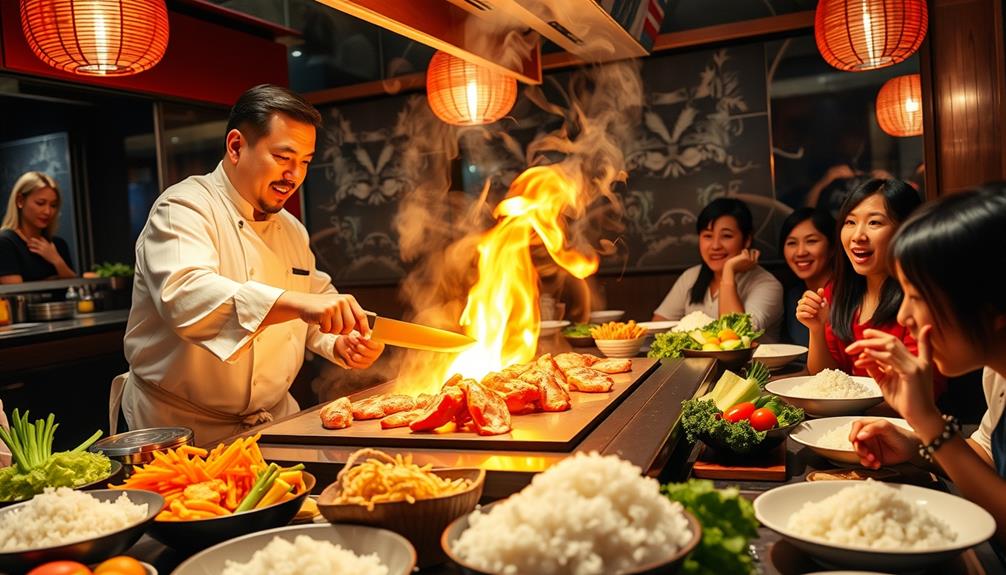
When you visit a hibachi restaurant, the chefs play an essential role in creating an unforgettable dining experience. Their culinary skills and engaging performances transform cooking into a lively show, keeping you entertained while your meal is prepared.
Much like the dynamic interactions seen in celebrity relationships, hibachi chefs have a knack for humor and audience interaction, ensuring each visit is unique and memorable.
Additionally, their ability to adapt and perform under pressure resonates with the resilience displayed by stars like Caleb Coffee after overcoming challenges.
Chef Performance and Engagement
At a hibachi restaurant, the role of the chef goes beyond cooking; they're performers who captivate diners with their skills and charisma. Hibachi chefs are often described as entertainers, engaging diners right from the moment they sit down. Their chef performances typically kick off with a dramatic introduction involving flaming oil, instantly setting the stage for an unforgettable experience.
This interactive approach aligns with principles of design thinking, as it emphasizes user-centric solutions and fosters a connection between the chef and the audience.
Throughout the meal, these chefs incorporate humor and tricks, tossing shrimp and squirting sake at willing participants, turning the cooking process into a lively show. This interactive approach not only entertains but also creates a connection between the chef and the audience, making your dining experience more memorable.
It's important to show respect for the chef during their performance, as they thrive on audience engagement and reactions to enhance the overall atmosphere. Mistakes, like failed tricks, often happen and add to the enjoyment, making the environment feel relaxed and fun.
Culinary Skills and Techniques
Mastering culinary skills and techniques is essential for hibachi chefs, who blend artistry with precision to create an unforgettable dining experience. These chefs often begin their careers with culinary training as line cooks, gradually honing their craft while incorporating entertaining elements into their cooking.
Yoga for back pain can also serve as a great practice for chefs to maintain flexibility and strength needed for their dynamic movements.
Key techniques include precise knife skills for chopping ingredients quickly and safely. You'll be amazed by their ability to perform visually engaging tricks, like the egg roll and onion volcano, that elevate your meal into a performance.
Charisma and humor play a significant role, as hibachi chefs actively engage with guests through jokes and storytelling while grilling food.
The high-temperature grilling methods they use allow for swift searing of meats and vegetables, maintaining rich flavors with the help of soybean oil and garlic.
As you enjoy the show, respect and attentiveness are essential, as chefs encourage audience participation, tossing shrimp for you to catch while carefully managing the cooking process.
This dynamic approach not only showcases the art of Japanese cuisine but also guarantees your safety and enjoyment throughout the meal.
Interactive Dining Experience
Hibachi chefs frequently transform a simple meal into an enchanting experience, engaging diners with their entertaining performances. As you gather around the grill, you'll quickly notice how these skilled chefs turn Japanese grilling into a lively show. They don't just cook; they invite you to participate, whether it's catching shrimp flying through the air or enjoying a playful sake squirt.
Their culinary artistry is reminiscent of the memorable moments showcased at celebrity events, where the atmosphere is filled with joy and excitement, much like Paula Deen's Wedding Highlights.
The chefs create a sense of anticipation by serving a first course of shrimp, setting the stage for the main entrees. Their humor and tricks, like the flaming oil introduction and the egg roll trick, keep the atmosphere vibrant. You can't help but be drawn into the excitement, surrounded by the sounds of sizzling food, clattering utensils, and the cheers of fellow diners.
While the hibachi chefs entertain, they also command respect for their culinary skills. It's clear that their ability to engage you and cook delicious meals simultaneously is what makes the interactive dining experience so special.
You'll leave not just satisfied, but with unforgettable memories of a meal that was truly a performance.
Menu Highlights
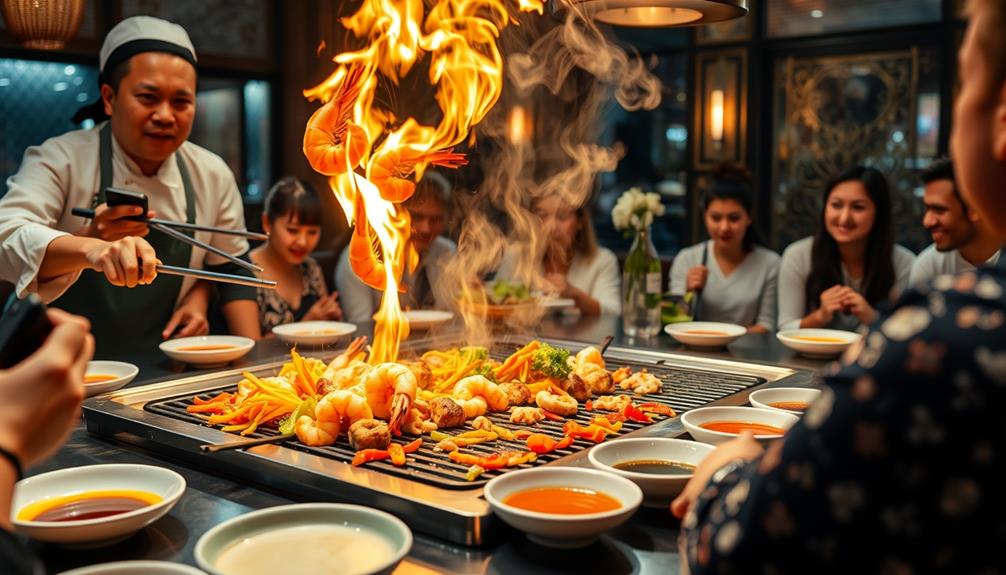
When you browse the menu at a hibachi restaurant, you'll discover a mouthwatering selection of appetizers, entrées, and sides that guarantee a delightful dining experience.
The excitement starts with appetizers like:
- Egg rolls
- Edamame
- Japanese dumplings
These tasty starters set the stage for the main event, often accompanied by entertaining chef performances that showcase their culinary skills.
Common hibachi entrées feature grilled meats such as chicken, steak, and shrimp, often served alongside fried rice and grilled vegetables, with many dishes benefiting from a proper diet and seasoning proper diet includes fresh fruits like garlic, soy sauce, and ginger.
Many diners kick off their meals with shrimp, prepared right before your eyes by skilled chefs, adding a touch of entertainment to your dining experience.
You'll also find plenty of options to customize your order, whether you prefer rice, noodles, or salads.
And if you're in the mood for something different, the menu often includes a variety of other Japanese food options like sushi, teriyaki, and noodle dishes.
These delicious choices guarantee everyone leaves satisfied, making hibachi dining a unique and enjoyable adventure.
Dining Atmosphere and Entertainment
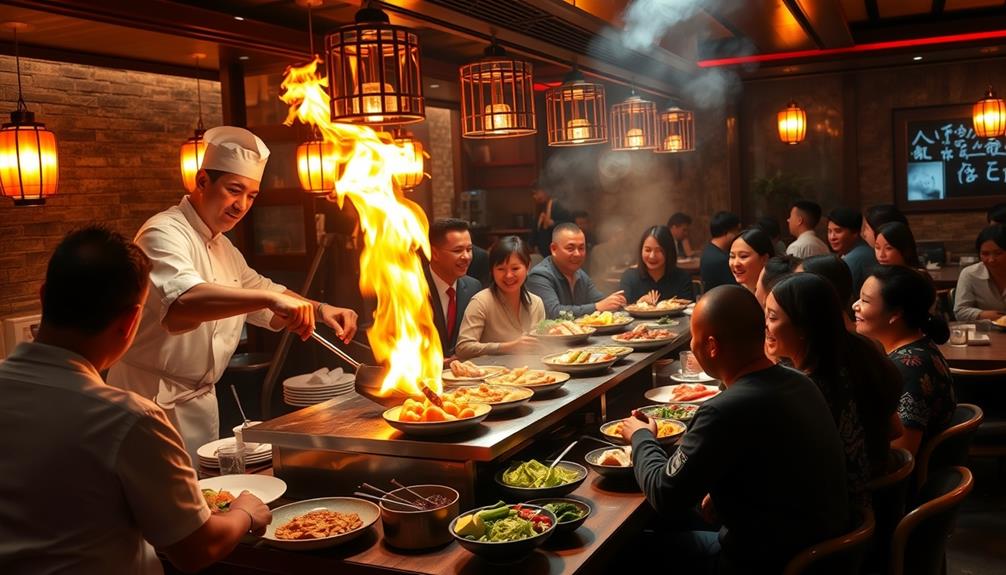
At a hibachi restaurant, you'll experience a dynamic atmosphere where chefs entertain you with their impressive cooking skills.
This lively scene is enhanced by the communal dining setup, reminiscent of the cultural impact of Star Wars, where you'll share your table with others, creating an environment filled with laughter and cheers.
With the sounds of sizzling grills and playful banter, every meal becomes a memorable event.
Interactive Chef Performances
The vibrant atmosphere of hibachi restaurants comes alive with interactive chef performances that transform meal preparation into an unforgettable show. As you sit around the hibachi grills, you'll be captivated by your chefs' grill skills and entertaining antics.
They turn cooking into a lively spectacle, blending culinary artistry with humor and flair. Many of these restaurants also offer unique dining experiences that rival family-friendly hotels with water parks, featuring engaging activities for guests of all ages, such as seasonal events and activities.
Here are three highlights of the interactive experience:
- Engaging Tricks: Chefs often incorporate fun activities, like tossing shrimp for you to catch or creating a "volcano" effect with onion rings, ensuring laughter fills the air.
- Cheerful Interactions: The atmosphere buzzes with the sounds of sizzling food and clattering tools, as chefs invite diners to participate, creating a sense of excitement and camaraderie.
- Memorable Mistakes: Even minor slip-ups become part of the charm, adding unique twists to each dining experience and making it truly one-of-a-kind.
In these Japanese restaurants, every meal is more than just food; it's an interactive experience that you'll remember long after the last bite.
Communal Dining Experience
Hibachi restaurants create a vibrant communal dining experience that immerses you in a spirited atmosphere. You'll sit around a shared table with about 15 people, fostering interaction, even with strangers. The engaging performances by Japanese chefs enhance this experience, as they showcase their culinary skills through entertaining tricks and jokes.
| Dining Experience | Description |
|---|---|
| Shared Seating | Sit with other diners, encouraging interaction |
| Chef Performances | Enjoy tricks like tossing shrimp and making onion volcanoes |
| Noise Levels | Celebrate with cheers and toasts, especially during busy hours |
| Varied Atmosphere | Experience lively weekends or quieter weeknights |
Your meal at a hibachi isn't just about the food; it's an event. The festive environment can get quite loud, particularly with alcohol service, but you might find a more subdued setting during lunch or weeknights. Whether you're celebrating a special occasion or just enjoying a night out, the communal dining experience at a hibachi restaurant is memorable and entertaining.
Lively Atmosphere and Sounds
Surrounded by the sounds of sizzling food and lively chatter, you can't help but feel the electric energy of a hibachi restaurant. The atmosphere is a whirlwind of excitement, where chefs showcase their skills and engage diners with entertaining hibachi cooking demonstrations.
You'll notice the vibrant environment is created by:
- Sizzling Grills: The constant hiss of food hitting the grills fills the air, making your mouth water in anticipation. The dynamic energy in the restaurant can be likened to the emotional volatility seen in individuals with BPD characteristics, where intense experiences take center stage.
- Cheerful Interactions: Chefs perform tricks and share humorous banter, drawing laughter and cheers from patrons, especially during iconic moments like the onion volcano.
- Camaraderie Among Guests: With strangers seated together, you'll experience a shared enjoyment that enhances the dining experience, as everyone celebrates the culinary show.
As the night progresses, the noise levels can rise considerably, particularly when alcohol is served.
The dim lighting and minimalistic decor keep the focus on the chefs and their enchanting performances, making for an unforgettable evening.
The lively atmosphere of a hibachi restaurant not only tantalizes your taste buds but also creates lasting memories filled with laughter and excitement.
Historical Origins of Hibachi
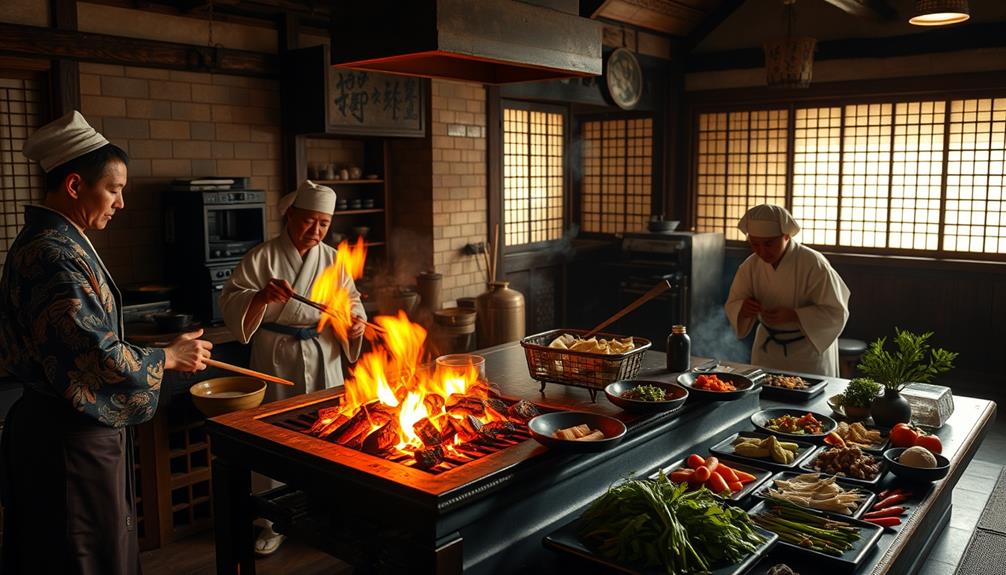
Japan's culinary history reveals that the term "hibachi," meaning "fire bowl," has roots tracing back to the Heian period (794-1185 AD). Initially, this term referred to an open-topped pot designed for warming hands and heating water rather than for cooking food.
It wasn't until the late 1800s that hibachi began evolving into a grill used for cooking, marking a significant shift toward grilling traditional Japanese treats. The charm and atmosphere of dining around a hibachi grill can create a unique experience, similar to how astrology explores personality traits that enhance individual appeal in social settings.
Over time, the hibachi grill, typically made from wood or ceramic lined with metal, adapted to meet the growing demand for grilling in Japan. This transformation allowed for a variety of dishes to be cooked right at the table, enhancing the dining experience.
While many people today confuse hibachi with teppanyaki, it's important to understand that hibachi specifically refers to the portable grill type.
This distinction is vital for appreciating the historical and culinary significance of hibachi in Japanese cuisine. By knowing its origins, you can better appreciate the rich tradition behind this grilling method and how it has shaped modern Japanese dining experiences.
Cooking Equipment Differences
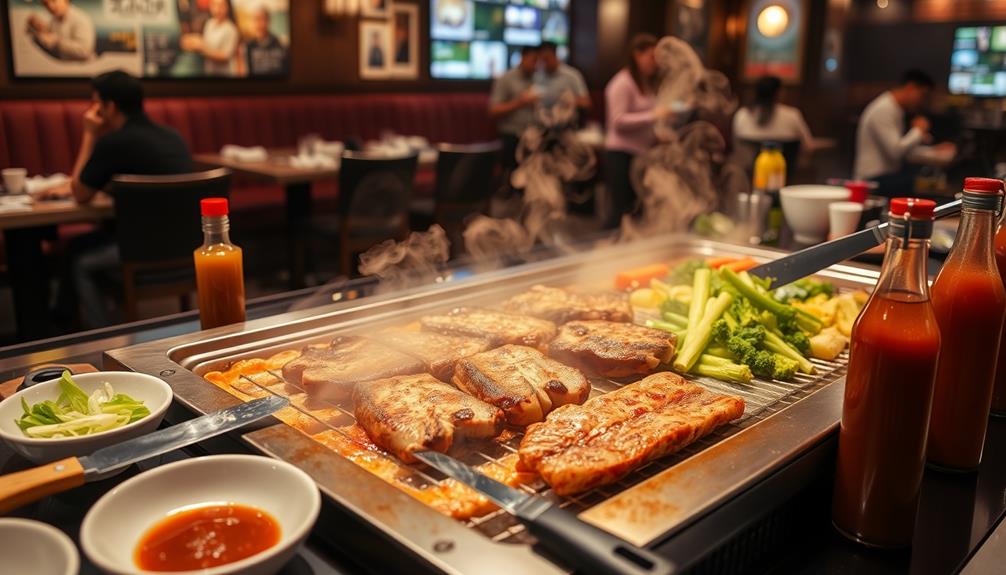
When it comes to cooking equipment, understanding the differences between hibachi and teppanyaki grills can enhance your dining experience. Each cooking method brings its unique flair and functionality to the table.
- Design: Hibachi grills typically feature an open-grate design, allowing for larger items to be cooked over charcoal or electric heat sources. In contrast, teppanyaki grills consist of a flat iron griddle fueled by propane flames for even cooking.
- Cooking Techniques: The hibachi grill's open design promotes high-temperature cooking, perfect for searing meats and vegetables. On the other hand, teppanyaki's flat surface is ideal for finely chopped sides like eggs and veggies, showcasing the chef's knife skills.
- Portability: Hibachi grills are often smaller and portable, making them suitable for outdoor use. Teppanyaki grills, however, are larger and designed for indoor restaurant settings, providing a different dining atmosphere.
Both hibachi and teppanyaki grills enhance your experience in distinct ways. Hibachi emphasizes the visual spectacle of open flames, while teppanyaki highlights the artistry of cooking techniques, leaving you with a memorable meal.
Popular Hibachi Dishes
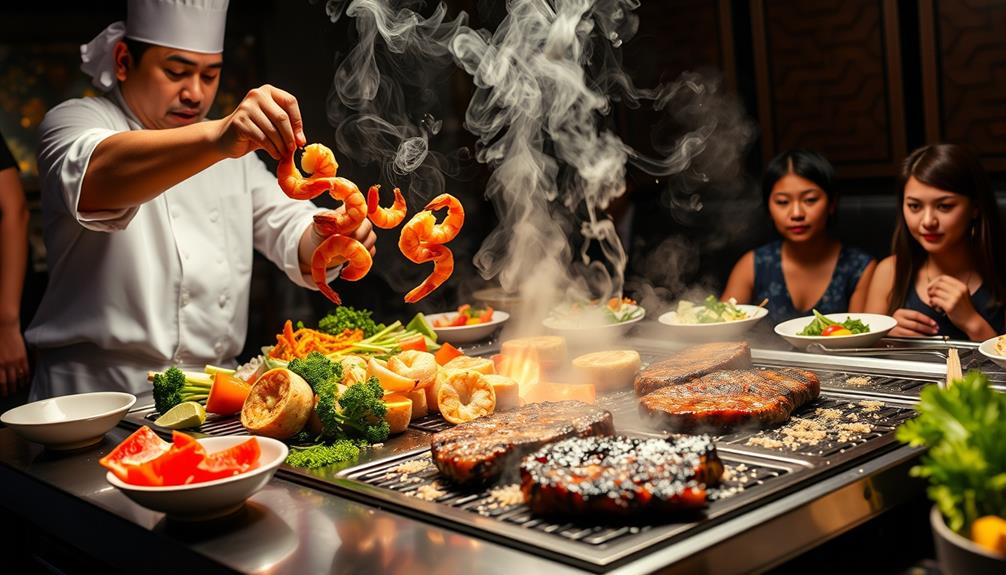
Savoring the vibrant flavors of popular hibachi dishes can transform any meal into a delightful experience.
You'll find hibachi chicken to be a standout choice, as it's tenderized and seared with butter and teriyaki sauce, creating a rich and flavorful entrée. If you're in the mood for something a bit different, hibachi shrimp is another favorite, often grilled or stir-fried with a sweet Japanese sauce that enhances its natural taste.
For those who love beef, hibachi steak is a must-try. Featuring thick cuts of beef or lamb, it's cooked to perfection and served with an umami gloss and mushroom sauce that elevates the entire dish.
Don't forget about the sides; hibachi vegetables are a staple, showcasing seasonal produce cooked to emphasize freshness and vibrant flavors.
Lastly, no hibachi meal is complete without hibachi rice. Typically fried with vegetables and your choice of protein, it's seasoned just right and serves as a delicious complement to your main dishes.
These hibachi dishes not only tantalize the taste buds but also create a memorable dining experience that you'll want to relive time and again.
Health Considerations in Hibachi Dining
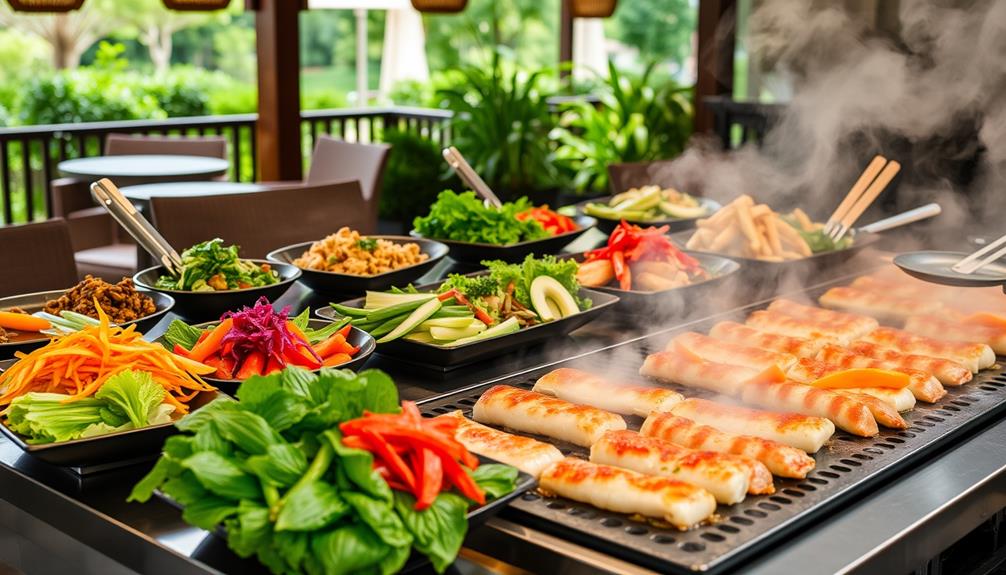
Many diners appreciate hibachi for its health-conscious options, which can make dining out a guilt-free pleasure. The cooking methods used in hibachi—high-temperature grilling and sautéing—usually result in lower fat content compared to frying. This allows you to enjoy flavorful hibachi meals without the extra calories.
To maximize the health benefits of your hibachi experience, consider these tips:
- Choose fresh meats and vegetables: Hibachi emphasizes fresh ingredients, which can enhance the nutritional value of your meal.
- Control portion sizes: Hibachi servings are often generous and designed for sharing, so you can share with friends or save some for later.
- Opt for healthy dishes: Many hibachi restaurants offer dishes that minimize sauces and seasonings, allowing you to enjoy the natural flavors of the ingredients.
Frequently Asked Questions
What Is the Meaning of Hibachi Restaurant?
A hibachi restaurant's meaning revolves around communal dining experiences where chefs grill food right before you. You'll enjoy fresh, hot dishes while being entertained, making it a lively and interactive way to savor Japanese cuisine.
What's so Special About Hibachi?
When you step into a hibachi restaurant, you're not just eating; you're witnessing a culinary show. Chefs dazzle you with skills, create vibrant flavors, and foster connections among diners, making every meal a memorable experience.
What Makes a Meal Hibachi?
To make a meal hibachi, you grill meats and vegetables over an open flame, focusing on high searing temperatures. You can customize flavors and enjoy an entertaining cooking experience, enhancing the meal's excitement and taste.
What Is the Purpose of a Hibachi?
You might think it's just about food, but the purpose of hibachi is to create an interactive dining experience. Watching skilled chefs prepare your meal enhances entertainment, making it a memorable occasion with friends or family.
Conclusion
To sum up, visiting a hibachi restaurant is more than just a meal; it's an experience filled with entertainment and delicious food. Did you know that about 80% of diners say they love the interactive cooking style and engaging chefs? So, the next time you're craving a fun dining adventure, consider hibachi. You'll not only enjoy mouthwatering dishes but also create lasting memories as chefs showcase their skills right before your eyes!

